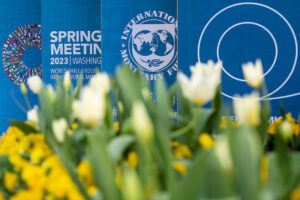




Policy Rate Updates: Double cut finale
 DOWNLOAD
DOWNLOAD

Monthly Economic Update: One for the road
 DOWNLOAD
DOWNLOAD

Inflation Update: Still low, still slow
 DOWNLOAD
DOWNLOAD


BSP sees no need to tap IMF lending programs

WASHINGTON — There is no need for the Philippines to tap the International Monetary Fund’s (IMF) lending programs, the Bangko Sentral ng Pilipinas (BSP) chief said on Wednesday.
BSP Governor Felipe M. Medalla said the country needs more official development assistance (ODA) from multilateral lending institutions.
Asked if there is a need to tap the IMF lending program, he replied: “Right now, I don’t think so.”
“We’re relying very heavily on ODA from the World Bank and ADB (Asian Development Bank), and direct commercial borrowing from abroad,” Mr. Medalla said on the sidelines of the IMF and World Bank spring meetings here.
The IMF provides financial support to countries hit by crises to stabilize their respective economies. Countries often come to the IMF when they have no other lending options.
The IMF does not lend for specific projects in countries unlike development banks.
For 2023, the National Government expects to obtain around USD 19.1 billion worth of ODA — USD 9.2 billion worth of loans from multilateral development partners and USD 9.8 billion in loans from bilateral lenders.
Also, Mr. Medalla said the country needs more capacity development from the IMF on monetary and fiscal operations.
“The last thing our central bank wants to do is to reinvent the wheel. So, we ask what other central banks are doing, how do (they) make monetary policy more effective,” he said.
Whenever the Philippine central bank is set to do what it has not done before, Mr. Medalla said it is important to look at how other countries responded to the issue and see what exact tools were used.
The IMF offers capacity development, which includes technical assistance and training, to its members upon request. Capacity development accounts for around a third of the IMF’s annual spending.
In 2021, the Philippines received USD 2.8 billion worth of Special Drawing Rights (SDRs) from the IMF, as part of the latter’s efforts to help countries recover from the coronavirus pandemic.
Member countries were allocated SDRs — the fund’s unit of exchange backed by dollars, euros, yen, sterling and yuan — in proportion to their quota shares in the IMF.
The IMF’s last SDR distribution came in 2009 when member countries received USD 250 billion in SDR reserves to help ease the global financial crisis. — By Keisha B. Ta-asan, Reporter
This article originally appeared on bworldonline.com





 By BusinessWorld
By BusinessWorld